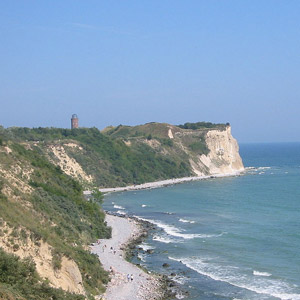Magazine | Voyages
Séjour sur l’île de Rügen et sur la presqu’île de Zingst (Allemagne) du 21 au 24 octobre 2004

Vue du cap Arkona, au nord de l’île de Rügen (Allemgne).Photographie : Andrea Steinhoff / Wikimedia Commons
Introduction
Rügen, la plus grande île allemande, est située dans le Mer Baltique. C’est une destination touristique très populaire en été, mais surtout une zone excellente pour l’observation des oiseaux, avec notamment un grand nombre de grues et d’oies de passage en automne. L’extrémité nord de l’île, le Kap Arkona, est une spot reconnu pour le suivi de la migration. En outre, les paysages y sont superbes, et les falaises crayeuses du parc national de Jasmund ont inspirées de nombreux peintres.
A l’ouest de l’île de Rügen, la côte allemande est restée très sauvage, avec des zones remarquables comme la péninsule de Zingst et l’île d’Hiddensee.
Nicolas Rasson et Thierry de Ryckel ont effectué un séjour ornithologique du 21 au 24 octobre 2004, et ils nous ont transmis leur rapport.
Abstract
Ruegen is the Germany’s largest island and is situated in the Baltic Sea. It is a very popular tourist area in summer. However, Rit has excellent breeding birds, particularly in the west, and large numbers of Common Crane and geese stop here in autumn. There are several nature reserves as well as the Jasmund National Park on the east coast. The northern tip, Kap Arkona, is good for migrants.
It is a traditional stopover for more than 25,000 Common Crane during September and October and also attracts waterfowl in good numbers. The White-tailed Eagle can also be seen wandering from breeding sites on neighbouring Usedom. A wide range of waders occur both as breeding birds and on passage and the seabirds include Caspian Tern which breeds on the nearby island of Heuwiese and can be seen off Ruegen. The Jasmund National Park with its spectacular chalk cliffs has breeding Thrush Nightingale, Red-breasted Flycatcher, Barred Warbler and Red-backed Shrike. Kap Arkona has breeding Scarlet Rosefinch.
The nearby coast at the west of Ruegen is also very interesting: Hiddensee is a narrow island west of Rügen that hosts one of the few German ornithological stations. The Darß/Zingst peninsula is also excellent for birding. In August the first families of Common Crane (Grus grus) will gather there, but peak numbers with many thousands of Common Cranes, for which the area is most famous, do not occur until October. Apart from waterbirds such as Goldeneye (Bucephala clangula) and Pied Avocet (Recurvirostra avosetta), large numbers of Mute Swans (Cygnus olor) gather here to breed and moult.
Nicolas Rasson and Thierry de Dickel visited this region of Germany from the 21 to the 24th of October 2004 and they sent us their report.
Poursuivez la lecture de cet article, en vous abonnant dès maintenant !
Découvrez les Archives d’Ornithomedia.com
Pour seulement 10,00 €TTC/an (ou 6,00 € les 6 mois)
Profitez de plusieurs centaines d’articles en accès illimité et sans aucun engagement.
Compléments
Auteur
Nicolas Rasson – Site web : www.naturasson.com
À lire aussi sur Ornithomedia.com
Le Döberitzer Heide, au pays de la Fauvette épervière
À lire sur le web
Le site web du parc national de Jasmund : www.nationalpark-jasmund.de
Ouvrages recommandés
- ADAC RadTourenKarte 08. Rügen, Fischland, Darß, Zingst, Stralsund. 1 : 75 000
de Martina Zöllner - Rügen / Hiddensee de Bernhard Jendricke
- Le guide Ornitho de Killian Mullarney
- Allemagne Collectif Michelin





Aucun commentaire sur ce sujet
Participer à la discussion !